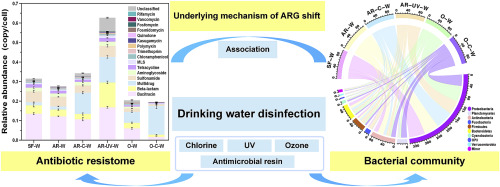当前位置:
X-MOL 学术
›
Water Res.
›
论文详情
Our official English website, www.x-mol.net, welcomes your
feedback! (Note: you will need to create a separate account there.)
Metagenomic profiling of antibiotic resistance genes and their associations with bacterial community during multiple disinfection regimes in a full-scale drinking water treatment plant.
Water Research ( IF 11.4 ) Pub Date : 2020-03-19 , DOI: 10.1016/j.watres.2020.115721 Shuyu Jia 1 , Kaiqin Bian 2 , Peng Shi 2 , Lin Ye 2 , Chang-Hong Liu 3
Water Research ( IF 11.4 ) Pub Date : 2020-03-19 , DOI: 10.1016/j.watres.2020.115721 Shuyu Jia 1 , Kaiqin Bian 2 , Peng Shi 2 , Lin Ye 2 , Chang-Hong Liu 3
Affiliation

|
For comprehensive insights into the effects of multiple disinfection regimes on antibiotic resistome in drinking water, this study utilized metagenomic approaches to reveal the changing patterns of antibiotic resistance genes (ARGs) and bacterial community as well as their associations. A total of 297 ARGs within 17 types were detected in the drinking water, and their total relative abundance ranged from 195.49 ± 24.85 to 626.31 ± 38.61 copies of ARGs per cell. The total ARG abundance was significantly increased after the antimicrobial resin and ultraviolet (AR/UV) disinfection while significantly decreased after the ozone and chlorine (O3/Cl2) disinfection and remained stable after AR/Cl2 disinfection. Overall, 18 ARGs including bacA, mexT, and blaOXA-12, mainly affiliated to bacitracin, multidrug, and beta-lactam, were persistent and discriminative during all the disinfection strategies in drinking water, and they were considered as key ARGs that represent the antibiotic resistome during drinking water disinfection. Additionally, possible hosts of 50% key ARGs were revealed based on co-occurrence network. During multiple disinfection processes, the change of Fusobacteriales and Aeromonadaceae in abundance mainly contributed to the abundance shift of bacA, and Pseudomonas mainly increased the abundance of mexT. These findings indicated that bacterial community shift may be the key factor driving the change of antibiotic resistome during disinfection. The strong association between antibiotic resistome alteration and bacterial community shift proposed in this study may enhance our understanding of the underlying mechanism of the disinfection effects on antibiotic resistance and benefit effective measures to improve safety of drinking water.
中文翻译:

大规模饮用水处理厂中多种消毒方式下抗生素抗性基因的元基因组分析及其与细菌群落的关联。
为了全面了解多种消毒方式对饮用水中抗生素抗药性的影响,本研究利用宏基因组学方法揭示了抗生素抗性基因(ARG)和细菌群落及其关联的变化模式。在饮用水中共检测到17种类型的297个ARG,每个细胞的总相对丰度范围为195.49±24.85至626.31±38.61拷贝。抗菌树脂和紫外线(AR / UV)消毒后,总的ARG丰度显着增加,而臭氧和氯(O3 / Cl2)消毒后,总的ARG丰度显着下降,AR / Cl2消毒后,总的ARG丰度保持稳定。总体而言,包括bacA,mexT和blaOXA-12在内的18种ARG,主要与杆菌肽,多种药物和β-内酰胺有关,在饮用水的所有消毒策略中均具有持久性和歧视性,它们被认为是代表饮用水消毒过程中抗生素抗药性的关键ARG。此外,基于共现网络,发现了可能存在50%关键ARG的主机。在多次消毒过程中,Fusobacteriales和Aeromonadaceae的丰度变化主要是造成bacA丰度的变化,而Pseudomonas则主要增加了mexT的丰度。这些发现表明,细菌群落的移动可能是驱动消毒过程中抗生素抵抗组变化的关键因素。
更新日期:2020-03-20
中文翻译:

大规模饮用水处理厂中多种消毒方式下抗生素抗性基因的元基因组分析及其与细菌群落的关联。
为了全面了解多种消毒方式对饮用水中抗生素抗药性的影响,本研究利用宏基因组学方法揭示了抗生素抗性基因(ARG)和细菌群落及其关联的变化模式。在饮用水中共检测到17种类型的297个ARG,每个细胞的总相对丰度范围为195.49±24.85至626.31±38.61拷贝。抗菌树脂和紫外线(AR / UV)消毒后,总的ARG丰度显着增加,而臭氧和氯(O3 / Cl2)消毒后,总的ARG丰度显着下降,AR / Cl2消毒后,总的ARG丰度保持稳定。总体而言,包括bacA,mexT和blaOXA-12在内的18种ARG,主要与杆菌肽,多种药物和β-内酰胺有关,在饮用水的所有消毒策略中均具有持久性和歧视性,它们被认为是代表饮用水消毒过程中抗生素抗药性的关键ARG。此外,基于共现网络,发现了可能存在50%关键ARG的主机。在多次消毒过程中,Fusobacteriales和Aeromonadaceae的丰度变化主要是造成bacA丰度的变化,而Pseudomonas则主要增加了mexT的丰度。这些发现表明,细菌群落的移动可能是驱动消毒过程中抗生素抵抗组变化的关键因素。











































 京公网安备 11010802027423号
京公网安备 11010802027423号